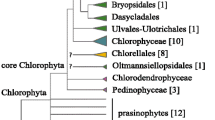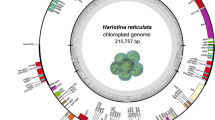Abstract
Our previous phylogenetic analysis based on cDNA sequences of chloroplast and cytosolic glyceraldehyde-3-phosphate dehydrogenases (GAPDH; genes GapA and GapC, respectively) of the red alga Chondrus crispus suggested that rhodophytes and green plants are sister groups with respect to plastids and mitochondria and diverged at about the same time or somewhat later than animals and fungi. Here we characterize the genomic sequences of genes GapC and GapA of C. crispus with respect to promotor structures, intron/exon organization, genomic complexity, G+C content, CpG suppression and their transcript levels in gametophytes and protoplasts, respectively. To our knowledge this is the first report on nuclear protein genes of red algae. The GapC gene is G+C-rich, contains no introns and displays a number of classic sequence motifs within its promotor region, such as TATA, CAAT, GC boxes and several elements resembling the plant-specific G-box palindrome. The GapA gene has a moderate G+C content, a single CAAT box motif in its promotor region and a single intron of 115 bp near its 5′ end. This intron occupies a conserved position corresponding to that of intron 1 in the transit peptide region of chloroplast GAPDH genes (GapA and GapB) of higher plants. It has consensus sequences similar to those of yeast introns and folds into a conspicuous secondary structure of - 61.3 kJ. CpG profiles of genes GapC and GapA and their flanking sequences show no significant CpG depletion suggesting that these genomic sequences are not methylated. Genomic Southern blots hybridized with generic and gene specific probes indicate that both genes are encoded by single loci composed of multiple polymorphic alleles. Northern hybridizations demonstrate that both genes are expressed in gametophytes but not in protoplasts where appreciable amounts of transcripts can only be detected for GapC.
Similar content being viewed by others
References
Antequera, F, Bird, AP: Unmethylated CpG islands associated with genes in higher plant DNA. EMBO J 7: 2295–2299 (1988).
Aota, S, Ikemura, T: Diversity in G+C content at the third base position of codons in vertebrate genes and its cause. Nucl Acids Res 14: 8129–8144 (1986).
Apt, KE, Grossman, AR: Characterization and transcript analysis of the major phycobiliprotein subunit genes from Aglaothamnion neglectum (Rhodophyta). Plant Mol Biol 21: 27–38 (1993).
Belanger, FC, Hepburn, AG: The evolution of CpNpG methylation in plants. J Mol Evol 30: 26–35 (1990).
Bernardi, G, Olofsson, B, Filipski, J, Zerial, M, Salinas, J, Cuny, G, Meunier-Rotival, M, Rodier, F: The mosaic genome of warm-blooded vertebrates. Science 228: 953–958 (1985).
Bird, AP: CpG-rich islands and the function of DNA methylation. Nature 321: 209–213 (1986).
Branlant, G, Branlant, C: Nucleotide sequence of the Escherichia coli gap gene. Different evolutionary behaviour of the NAD +-binding domain and the catalytic domain of d-glyceraldehyde-3-phosphate dehydrogenase. Eur J Biochem 150: 61–66 (1985).
Brinkmann, H, Cerff, R, Salomon, M, Soll, J: Cloning and sequence analysis of cDNAs encoding the cytosolic precursors of subunits GapA and GapB of chloroplast glyceraldehyde-3-phosphate dehydrogenase from pea and spinach. J Plant Mol Biol 13: 81–94 (1989).
Brinkmann, H, Martinez, P, Martin, W, Quigley, F, Cerff, R: Endosymbiotic origin and codon bias of the nuclear gene for chloroplast glyceraldehyde 3-phosphate dehydrogenase from maize. J Mol Evol 26: 320–328 (1987).
Cerff, R: Separation and purification of NAD- and NADP-linked glyceraldehyde-3-phosphate dehydrogenases from higher plants. In: Edelmann, M, Hallick, RB, Chua, NH (eds) Methods in Chloroplast Molecular Biology, pp. 683–694. Elsevier Biomedical Press, Amsterdam (1982).
Cerff, R, Kloppstech, K: Structural diversity and differential light control of mRNAs coding for angiosperm glyceraldehyde-3-phosphate dehydrogenases. Proc Natl Acad Sci USA 79: 7624–7628 (1982).
Doolittle, RF, Feng, DF, Anderson, KL, Alberro, MR: A naturally occuring horizontal gene transfer from a eukaryote to a prokaryote. J Mol Evol 31: 383–388 (1990).
Doolittle, WF: The origin and function of intervening sequences in DNA: a review. Am Nat 130: 915–928 (1987).
Dynan, WS, Tjian, R: Control of eukaryotic messenger RNA synthesis by sequence-specific DNA-binding proteins. Nature 316: 774–778 (1985).
Feinberg, AP, Vogelstein, B: A technique for radiolabelling DNA restriction endonuclease fragments to high specific activity. Anal Biochem 137: 266–267 (1984).
Fink, GR: Pseudogenes in yeast. Cell 49: 5–6 (1987).
Galun, E: Plant protoplasts as physiological tools. Annu Rev Plant Physiol 32: 237–266 (1981).
Gardiner-Garden, M, Frommer, M: CpG islands in vertebrate genomes. J Mol Biol 196: 261–282 (1987).
Gardiner-Garden, M, Frommer, M: Significant CpG-rich regions in angiosperm genes. J Mol Evol 34: 231–245 (1992).
Gardiner-Garden, M, Sved, JA, Frommer, M: Methylation sites in angiosperm genes. J Mol Evol 34: 219–230 (1992).
Gilbert, W: The exon theory of genes. Cold Spring Harbor Symp Quant Biol 52: 901–905 (1987).
Gruenbaum, Y, Stein, R, Cedar, H, Razin, A: Sequence specificity of methylation in higher plant DNA. Nature 292: 860–862 (1981).
Guarente, L, Bermingham-McDonogh, O: Conservation and evolution of transcriptional mechanisms in eukaryotes. Trends Genet 8: 27–32 (1992).
Hanauer, A, Mandel, JL: The glyceraldehyde 3-phosphate dehydrogenase gene family: structure of a human cDNA and of an X chromosome linked pseudogene; amazing complexity of the gene family in mouse: EMBO J 3: 2627–2633 (1984).
Hohn, B: In vitro packaging of I and cosmid DNA. Meth Enzymol 68: 299 (1979).
Joshi, CP: An inspection of the domain between putative TATA box and translation start site in 79 plant genes. Nucl Acids Res 15: 6643–6653 (1987).
Katagiri, F, Chua, NH: Plant transcription factors: present knowledge and future challenges. Trends Genet 8: 22–27 (1992).
Kersanach R, Brinkmann H, Liaud M-F, Zhang D-X, Martin W, Cerff R: Five identical intron positions in ancient duplicated genes of eubacterial origin. Nature, in press (1993).
Krainer, AR, Maniatis, T: RNA splicing. In: Hames, BD, Glover, DM (eds) Transcription and Splicing, pp. 131–206. IRL Press, Oxford (1988).
Kuhlemeier, C: Transcriptional and post-transcriptional regulation of gene expression in plants. Plant Mol Biol 19: 1–14 (1992).
LeGall, Y, Braud, JP, Kloareg, B: Protoplast production in Chondrus crispus gametophytes (Gigartinales, Rhodophyta). Plant Cell Rep 8: 582–585 (1990).
Liaud, M-F, Zhang, DX, Cerff, R: Differential intron loss and endosymbiotic transfer of chloroplast glyceraldehyde-3-phosphate genes to the nucleus. Proc Natl Acad Sci USA 87: 8918–8922 (1990).
Liaud M-F, Valentin C, Martin W, Bouget FY, Kloareg B, Cerff R: The evolutionary origin of red algae as deduced from the nuclear genes encoding cytosolic and chloroplast glyceraldehyde-3-phosphate dehydrogenases from Chondrus crispus. J Mol Evol, in press (1993).
Maniatis, T, Fritsch, EF, Sambrook, G: Construction of genomic libraries. In: Molecular Cloning: A Laboratory Manual, pp. 270–307. Cold Spring Harbor Laboratory, Cold Spring Harbor, NY (1982).
Martin, W, Brinkmann, H, Savona, C, Cerff, R: Evidence for a chimeric nature of nuclear genomes: Eubacterial origin of eukaryotic glyceraldehyde-3-phosphate dehydrogenase genes. Proc Natl Acad Sci USA 90: 8692–8696 (1993).
Martin, W, Cerff, R: Prokaryotic features of a nucleus-encoded enzyme. cDNA sequences for chloroplast and cytosolic glyceraldehyde-3-phosphate dehydrogenases from mustard (Sinapis alba). Eur J Biochem 159: 323–331 (1986).
Martin, W, Gierl, A, Saedler, H: Molecular evidence for pre-Cretaceous angiosperm origins. Nature 339: 46–48 (1989).
Martin, W, Lydiate, D, Brinkmann, H, Forkmann, G, Saedler, H, Cerff, R: Molecular phylogenies in angiosperm evolution. Mol Biol Evol 10: 140–162 (1993).
Martinez, P, Martin, W, Cerff, R: Structure, evolution and anaerobic regulation of a nuclear gene encoding cytosolic glyceraldehyde-3-phosphate dehydrogenase from maize. J Mol Biol 208: 551–565 (1989).
Michels, PAM, Marchand, M, Kohl, L, Allert, S, Wierenga, RK, Opperdoes, FR: The cytosolic and glycosomal isoenzymes of glyceraldehyde-3-phosphate dehydrogenase in Trypanosoma brucei have a distant evolutionary relationship. Eur J Biochem 198: 421–428 (1991).
Oeda, K, Salinas, J, Chua, NH: A tobacco bZip transcription activator (TAF-1) binds to a G-box-like motif conserved in plant genes. EMBO J 10: 1793–1802 (1991).
Oelmüller, R: Photooxidative destruction of chloroplasts and its effect on nuclear gene expression and extraplastidic enzyme levels. Photochem Photobiol 49: 229–239 (1989).
Perlman, PS, Peebles, CL, Daniels, C: Different types of introns and splicing mechanisms. In: Stone, EM, Schwartz, RJ (eds) Intervening Sequences in Evolution and Development, pp. 112–161. Oxford University Press, Oxford (1990).
Piechaczyk, M, Blanchard, JM, Sabouty, SRE, Dani, C, Marty, L, Jeanteur, P: Unusual abundance of glyceraldehyde 3-phosphate dehydrogenase pseudogenes in vertebrate genomes. Nature 312: 469–471 (1984).
Prabhala, G, Rosenberg, GH, Käufer, NF: Architectural features of pre-mRNA introns in the fission yeast Schizosaccharomyces pombe. Yeast 8: 171–182 (1992).
Quigley, F, Brinkmann, H, Martin, W, Cerff, R: Strong functional GC pressure in a light regulated maize gene encoding subunit GAPA of chloroplast glyceraldehyde-3-phosphate dehydrogenase: implications for the evolution of GAPA pseudogenes. J Mol Evol 29: 412–421 (1989).
Quigley, F, Martin, W, Cerff, R: Intron conservation across the prokaryote-eukaryote boundary: Structure of the nuclear gene for chloroplast glyceraldehyde-3-phosphate dehydrogenase from maize. Proc Natl Acad Sci USA 85: 2672–2676 (1988).
Ruby, SW, Abelson, J: Pre-mRNA splicing in yeast. Trends Genet 7: 79–85 (1991).
Russell, DA, Sachs, MM: The maize cytosolic glyceraldehyde-3-phosphate dehydrogenase gene family: organ-specific expression and genetic analysis. Mol Gen Genet 229: 219–228 (1991).
Salinas, J, Matassi, G, Montero, LM, Bernardi, G: Compositional compartmentalization and compositional patterns in the nuclear genomes of plants. Nucl Acids Res 16: 4269–4285 (1988).
Sambrook, J, Fritsch, EF, Maniatis, T: Molecular Cloning: A Laboratory Manual, 2nd ed. Cold Spring Harbor Laboratory Press, Cold Spring Harbor, NY (1989).
Shapiro, HS: Distribution of purines and pyrimidines in deoxyribonucleic acids. In: Fasman, GD (ed.) Handbook of Biochemistry and Molecular Biology, pp. 241–275. CRC Press, Cleveland, OH (1976).
Shih, MC, Lazar, G, Goodman, HM: Evidence in favor of the symbiotic origin of chloroplasts: Primary structure and evolution of tobacco glyceraldehyde-3-phosphate dehydrogenases. Cell 47: 73–80 (1986).
Shih, MC, Lazar, G, Goodman, HM: Cloning and chromosomal mapping of nuclear genes encoding chloroplast and cytosolic glyceraldehyde-3-phosphate- dehydrogenase from Arabidopsis thaliana (Corrigendum). Gene 119: 317–319 (1992).
Sinibaldi, RM, Mettler, IJ: Intron splicing and intron-mediated enhanced expression in monocots. Progr Nucl Acid Res Mol Biol 42: 229–257 (1992).
Smith, TL: Disparate evolution of yeasts and filamentous fungi indicated by phylogenetic analysis of glyceraldehyde-3-phosphate dehydrogenase genes. Proc Natl Acad Sci USA 86: 7063–7066 (1989).
Stone, EM, Rothblum, KN, Alevy, MC, Kuo, TM, Schwartz, RJ: Complete sequence of the chicken glyceraldehyde-3-phosphate dehydrogenase gene. Proc Natl Acad Sci USA 82: 1628–1632 (1985).
Taylor, WC: Regulatory interactions between nuclear and plastid genomes. Annu Rev Plant Physiol Plant Mol Biol 40: 211–233 (1989).
Liaud MF, Valentin C, Bouget FY, Kloareg B, Cerff R: Molecular phylogeny of red algae as revealed by nuclear genes encoding chloroplast and cytosol specific proteins. In: Sato S, Ishida M, Ishikawa H (eds) Endocytobiology V, pp. 357–361. Tübingen University Press (1993).
Author information
Authors and Affiliations
Rights and permissions
About this article
Cite this article
Liaud, MF., Valentin, C., Brandt, U. et al. The GAPDH gene system of the red alga Chondrus crispus: promotor structures, intron/exon organization, genomic complexity and differential expression of genes. Plant Mol Biol 23, 981–994 (1993). https://doi.org/10.1007/BF00021813
Received:
Accepted:
Issue Date:
DOI: https://doi.org/10.1007/BF00021813




